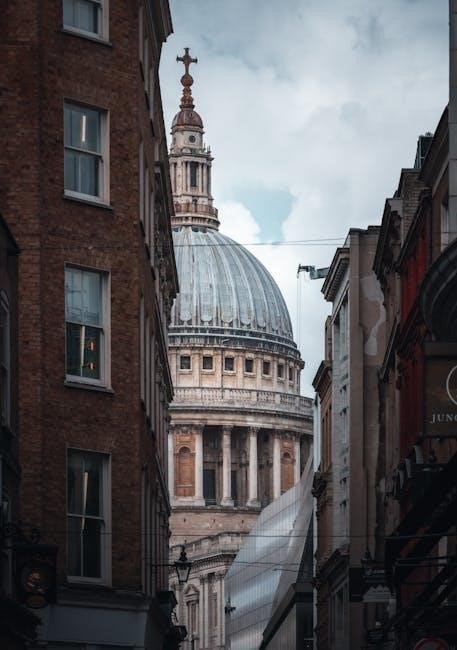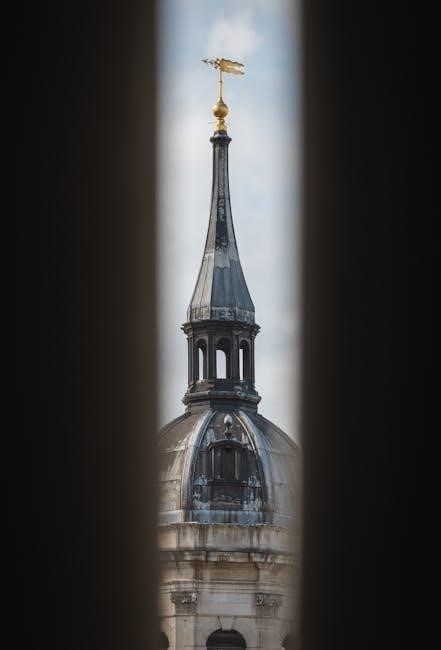The Great Gatsby‚ F․ Scott Fitzgerald’s timeless masterpiece‚ explores themes of the American Dream and social stratification․
Its enduring appeal makes it widely available as a free PDF‚ allowing readers to delve into Gatsby’s tragic pursuit of Daisy and wealth․
Overview of the Novel and Its Significance
F․ Scott Fitzgerald’s The Great Gatsby is a seminal work of 20th-century literature‚ set in the vibrant yet morally corrupt world of 1920s America․ The novel explores themes of the American Dream‚ class divisions‚ and the illusion of social mobility․ Through the tragic love story of Jay Gatsby and Daisy Buchanan‚ Fitzgerald critiques the excesses of capitalism and the decay of moral values․ Its intricate characters‚ vivid settings‚ and profound symbolism have made it a timeless classic․ The novel’s enduring relevance lies in its commentary on societal issues‚ making it a must-read for understanding the Jazz Age and its cultural legacy․ Its availability as a free PDF ensures widespread accessibility for readers worldwide․
Why The Great Gatsby Remains Relevant Today
The Great Gatsby’s relevance today stems from its timeless critique of societal issues‚ such as materialism‚ inequality‚ and the pursuit of an unattainable dream․ Fitzgerald’s portrayal of the Jazz Age mirrors contemporary concerns about wealth disparity and social stratification․ The novel’s exploration of love‚ illusion‚ and disillusionment continues to resonate with modern audiences‚ offering insights into human nature and ambition․ Its themes of moral decay and the corrupting influence of power remain poignant in today’s world․ Additionally‚ the availability of The Great Gatsby PDF free ensures that its messages reach a broad audience‚ making it a vital text for understanding both past and present societies․

Plot Summary of The Great Gatsby
The Great Gatsby‚ set in the 1920s‚ follows Jay Gatsby’s tragic pursuit of Daisy Buchanan․ Narrated by Nick Carraway‚ it explores themes of love‚ greed‚ and illusion‚ culminating in a devastating conclusion that underscores the futility of chasing an unattainable dream․
Setting: The Roaring Twenties
The Great Gatsby is set during the vibrant and tumultuous 1920s‚ an era of jazz‚ flapper culture‚ and economic prosperity․ The story unfolds in Long Island and New York City‚ contrasting the opulence of East Egg with the moral decay of the Valley of Ashes․ The Roaring Twenties backdrop highlights themes of social change‚ excess‚ and the clash between old money and new riches․ Fitzgerald vividly captures the atmosphere of a society transitioning from traditional values to modern hedonism‚ providing a rich context for Gatsby’s tragic pursuit of the American Dream․
Key Characters: Gatsby‚ Daisy‚ Tom‚ and Nick
Jay Gatsby‚ the mysterious millionaire‚ is driven by his obsession with winning back Daisy Buchanan‚ embodying the tragic pursuit of an unattainable dream․ Daisy‚ delicate and elusive‚ represents the epitome of wealth and grace‚ yet her indecision seals Gatsby’s fate․ Tom Buchanan‚ Daisy’s husband‚ symbolizes old money and entitlement‚ his arrogance and affair with Myrtle reflecting moral decay․ Nick Carraway‚ the narrator‚ serves as the moral compass‚ observing the chaos with Midwestern sensibility․ Together‚ these characters navigate love‚ betrayal‚ and social hierarchies‚ creating a complex tapestry of human flaws and aspirations in Fitzgerald’s timeless narrative․
Central Conflict: Gatsby’s Quest for Daisy
Gatsby’s central conflict revolves around his relentless pursuit of Daisy Buchanan‚ driven by a romantic obsession rooted in their past relationship․ His determination to win her back from the wealthy and arrogant Tom Buchanan fuels the novel’s tension․ Through extravagant parties and strategic maneuvers‚ Gatsby attempts to bridge the social divide and reclaim Daisy’s love․ However‚ the rigid class structures and Daisy’s own ambivalence create insurmountable obstacles․ This quest ultimately leads to tragedy‚ as Gatsby’s dream of reuniting with Daisy collapses‚ revealing the elusiveness of the American Dream and the destructive power of obsession․ The conflict underscores themes of love‚ illusion‚ and societal constraints․

Major Themes in The Great Gatsby
Fitzgerald explores the illusion of the American Dream‚ class divisions‚ the corrupting influence of wealth‚ and the tragic consequences of chasing unattainable love in the Jazz Age․
The American Dream and Its Illusion
The Great Gatsby critiques the American Dream through Jay Gatsby’s rags-to-riches journey‚ revealing its illusion․ Gatsby’s pursuit of wealth and Daisy symbolizes the nation’s aspirations‚ yet his tragic end exposes the Dream’s unattainability․ Fitzgerald portrays how materialism and social class corrupt ideals‚ leaving disillusionment․ The novel shows that the Dream‚ often seen as a path to happiness‚ can lead to moral decay and loss․ Through Gatsby’s story‚ Fitzgerald highlights the tension between old money and new riches‚ illustrating how the Dream’s promise of equality is an illusion in a stratified society․ This theme remains relevant in modern America‚ sparking reflection on social mobility and inequality․
Class and Social Stratification
The Great Gatsby vividly portrays class divisions in the 1920s through its characters․ Old money‚ represented by the Buchanans‚ symbolizes power and exclusivity‚ while new riches‚ embodied by Gatsby‚ reflect ambition and instability․ The Valley of Ashes‚ a desolate industrial area‚ highlights the moral decay between these worlds․ Fitzgerald critiques the rigid social hierarchy‚ showing how class dictates opportunities and relationships․ Daisy and Tom’s marriage exemplifies the enduring grip of old money‚ while Gatsby’s pursuit of Daisy fails to bridge the gap․ This stratification underscores the novel’s themes of inequality and the impossibility of transcending one’s social origins‚ resonating with readers today;
Love‚ Illusion‚ and Disappointment
Gatsby’s all-consuming love for Daisy drives the novel’s tragic narrative‚ blending illusion with reality․ His obsession‚ rooted in a past romance‚ fuels a dream of reclaiming her from Tom․ Yet‚ Daisy’s indecision and ultimate choice to remain with Tom shatter Gatsby’s illusions․ The green light across the water symbolizes the unattainable nature of his desire‚ while the Valley of Ashes reflects the moral decay beneath their romantic facade․ Fitzgerald portrays love as both a redemptive force and a destructive illusion‚ highlighting the impossibility of recapturing the past․ This theme resonates deeply‚ as Gatsby’s pursuit of love ultimately leads to his downfall and the exposure of societal superficiality․
Morality and Corruption
Morality and corruption are central themes in The Great Gatsby‚ as Fitzgerald critiques the ethical decay of the wealthy elite․ Tom’s infidelity and exploitation of Myrtle Wilson underscore his moral bankruptcy‚ while Daisy’s complicity in Gatsby’s death reveals her lack of accountability․ Gatsby‚ though romanticized‚ is implicated in illegal activities to achieve his goals․ The Valley of Ashes‚ a desolate wasteland between Long Island and New York‚ symbolizes the moral rot beneath the glamorous facade of the Jazz Age․ Fitzgerald’s portrayal of a society governed by greed and hypocrisy highlights the corrupting influence of wealth‚ leaving characters trapped in a cycle of moral decay and disillusionment․
The Jazz Age and Its Cultural Impact
The Great Gatsby vividly captures the Jazz Age‚ an era of cultural transformation and moral ambiguity․ The 1920s‚ marked by economic prosperity and social change‚ saw the rise of jazz music‚ flapper culture‚ and excessive parties‚ all reflected in Fitzgerald’s portrayal of Gatsby’s lavish lifestyle․ The novel highlights the tension between old-money aristocracy and the nouveau riche‚ as well as the exploitation of jazz and its cultural significance․ Fitzgerald’s critique of the Jazz Age’s excesses and moral decay resonates deeply‚ offering a timeless commentary on the fragility of societal norms․ The novel remains a cornerstone of literary analysis‚ exploring the intersection of culture‚ identity‚ and the American Dream‚ now accessible for free in PDF formats worldwide․

Character Analysis
The Great Gatsby delves into the complexities of its characters‚ with Gatsby as the enigmatic protagonist‚ Daisy as the elusive love interest‚ Tom as the entitled aristocrat‚ and Nick as the moral guide‚ each driving the novel’s tragic narrative and themes․
Jay Gatsby: The Enigmatic Protagonist
Jay Gatsby‚ the enigmatic protagonist of F․ Scott Fitzgerald’s The Great Gatsby‚ is a self-invented man shrouded in mystery․ Born James Gatz‚ he transformed himself into a wealthy aristocrat‚ chasing the American Dream․ His grand parties and extravagant lifestyle mask a deep obsession with winning back Daisy Buchanan‚ his lost love․ Gatsby’s identity is a carefully crafted illusion‚ reflecting his belief in reinvention․ Despite his material success‚ his quest for Daisy reveals a tragic vulnerability․ His story becomes a commentary on class‚ love‚ and the elusiveness of perfection․ Through his rise and fall‚ Gatsby embodies the fragility of aspiration and the corrupting influence of wealth․
Daisy Buchanan: The Elusive Love Interest
Daisy Buchanan‚ the elusive love interest of Jay Gatsby‚ is a complex figure embodying privilege‚ beauty‚ and indecision․ Her voice‚ described as “full of money‚” reflects her luxurious upbringing and societal status․ Daisy’s character is a blend of charm and passivity‚ often torn between her marriage to Tom and her lingering feelings for Gatsby․ She represents the unattainable American Dream that Gatsby tirelessly pursues․ Daisy’s inability to choose between her past and present leads to tragic consequences‚ illustrating the destructive power of nostalgia and the rigid social structures of the 1920s․ Her character serves as a critique of the empty materialism and moral decay of the elite․
Tom Buchanan: The Symbol of Old Money
Tom Buchanan‚ a wealthy and arrogant aristocrat‚ embodies the corrupting influence of old money in The Great Gatsby․ His imposing physical presence and aggressive demeanor reflect his dominance over those around him․ Tom’s infidelity and moral decay highlight the moral bankruptcy of the elite‚ contrasting sharply with Gatsby’s romantic idealism․ His rigid adherence to social hierarchy and racial superiority underscores the novel’s critique of class stratification․ As Daisy’s husband‚ Tom symbolizes the unattainable past that Gatsby longs for‚ making him a central figure in the tragic unfolding of events․ His character serves as a powerful symbol of privilege and decay in the Jazz Age․
Nick Carraway: The Moral Compass
Nick Carraway‚ the narrator of The Great Gatsby‚ serves as the moral anchor of the novel․ His Midwestern upbringing instills in him a sense of honesty and fairness‚ which contrasts sharply with the decadence of the East Coast elite․ As an outsider‚ Nick observes the events with a critical yet empathetic eye‚ providing a balanced perspective․ His relatability and integrity make him a trustworthy guide for readers navigating the complex world of Gatsby and the Buchanans․ Despite being drawn into their orbit‚ Nick retains his moral grounding‚ ultimately serving as a bridge between the reader and the characters․ His Midwestern values highlight the moral decay of the wealthy‚ adding depth to Fitzgerald’s critique of society․

Symbols and Motifs
The green light symbolizes the elusive American Dream‚ while the Valley of Ashes represents moral decay․ These motifs underscore Fitzgerald’s critique of wealth and societal corruption․
The Green Light: Symbol of the Elusive Dream
The green light across the water is a potent symbol in The Great Gatsby‚ representing the elusive American Dream․ Gatsby’s longing gaze at the light underscores his unattainable aspirations․ Fitzgerald uses this motif to critique the illusion of perfection and the futility of chasing an unachievable goal․ The light’s significance evolves throughout the novel‚ transitioning from hope to despair‚ mirroring Gatsby’s tragic journey․
Download a free PDF of The Great Gatsby to explore how Fitzgerald masterfully weaves this symbol into the narrative‚ reflecting the broader societal commentary on class and ambition in the Jazz Age․
The Valley of Ashes: Moral Decay and Desolation
The Valley of Ashes‚ a desolate industrial wasteland between Long Island and New York City‚ symbolizes moral decay and societal corruption in The Great Gatsby․ This grim area‚ marked by ash heaps and poverty‚ contrasts sharply with the opulence of the wealthy communities․ It is here that George and Myrtle Wilson reside‚ embodying the despair and desperation of the working class․ The Valley serves as a moral checkpoint‚ where the facade of wealth and privilege is stripped away‚ revealing the rot beneath․ The green light across the water‚ often associated with Gatsby’s longing‚ is starkly juxtaposed with the Valley’s bleakness‚ highlighting the elusiveness of the American Dream․
Download a free PDF to explore this haunting setting and its significance in Fitzgerald’s critique of societal inequality․
The Eyes of Doctor T․J․ Eckleburg: Godlike Judgment
The towering eyes of Doctor T․J․ Eckleburg‚ emblazoned on a faded billboard in the Valley of Ashes‚ serve as a haunting symbol of divine judgment and moral oversight․ These colossal eyes‚ devoid of a body‚ watch over the moral decay and corruption of the characters‚ embodying a higher power’s silent condemnation․ Their presence underscores the theme of accountability‚ as the characters’ actions are implicitly judged against a moral standard․ The eyes also symbolize the all-seeing nature of societal expectations‚ particularly the elusive American Dream․ Accessing a free PDF of The Great Gatsby allows readers to delve deeper into this powerful motif and its implications for the novel’s themes;

Freudian Analysis of The Great Gatsby
F․ Scott Fitzgerald’s masterpiece lends itself to Freudian analysis‚ exploring Gatsby’s obsession with Daisy as an unconscious drive․ The novel delves into the id‚ ego‚ and superego through characters like Gatsby‚ Daisy‚ and Tom‚ revealing how unconscious desires lead to tragic consequences․
Psychoanalytic Perspectives on Gatsby’s Obsession
Freudian analysis reveals Gatsby’s obsession with Daisy as a manifestation of the unconscious mind‚ driven by unattainable desires and repressed emotions․ His lavish lifestyle and parties symbolize an attempt to bridge the gap between his idealized fantasy and reality․ Gatsby’s fixation on Daisy embodies the id’s relentless pursuit of pleasure‚ while his calculated efforts to win her back reflect the ego’s struggle to reconcile fantasy with societal norms․ The green light across the water‚ a symbol of the elusive American Dream‚ further underscores the futility of his quest․ Ultimately‚ Gatsby’s tragedy illustrates the destructive power of unchecked desires and the impossibility of recapturing the past․ His story serves as a profound exploration of the human psyche‚ where illusion and reality collide․
The Role of the Unconscious in Character Behavior
In The Great Gatsby‚ the unconscious mind significantly influences character actions‚ revealing underlying desires and repressed emotions․ Gatsby’s relentless pursuit of Daisy stems from an unconscious yearning to reclaim a lost past‚ driven by idealized memories rather than reality․ Daisy‚ torn between love and security‚ embodies the conflict between her conscious choices and unconscious longing․ Tom’s arrogance and infidelity reflect his repressed guilt and fear of losing status․ The green light symbolizes the elusive American Dream‚ representing the unconscious aspirations of the characters․ Through these dynamics‚ Fitzgerald illustrates how the unconscious shapes decisions‚ often leading to tragic consequences․ The novel thus explores the tension between conscious intent and unconscious motivation․

Cultural and Social Analysis
Fitzgerald’s portrayal of 1920s society reveals deep racial and class divides‚ with characters like Tom embodying old-money privilege and Gatsby representing self-made ambition․ The Jazz Age backdrop highlights cultural shifts and moral decay‚ reflecting the era’s tension between tradition and progress․ The novel critiques the social stratification and hypocrisy of the time‚ offering a vivid commentary on identity and wealth․ These themes remain relevant today‚ underscoring the enduring social commentary of Fitzgerald’s work․
Marriage and Wealth in the 1920s
In the 1920s‚ marriage often served as a union of social status and economic security‚ rather than love․ Wealthy women like Daisy Buchanan were expected to marry within their class‚ maintaining family prestige․ This societal norm is central to The Great Gatsby‚ where Daisy’s marriage to Tom symbolizes the rigid stratification of the time․ Fitzgerald critiques the old-money elite‚ highlighting their moral decay beneath a veneer of sophistication․ Gatsby’s pursuit of Daisy challenges this system‚ illustrating the tension between old money and self-made wealth․ The novel exposes how wealth shaped relationships‚ reinforcing class divisions and limiting women’s agency in a patriarchal society․
Race and Identity in The Great Gatsby
Race and identity in The Great Gatsby reflect the prejudices of the 1920s․ Tom Buchanan’s beliefs in white supremacy and his disdain for other races underscore the era’s racial tensions․ Fitzgerald portrays characters like Meyer Wolfsheim‚ often stereotyped as a Jewish criminal‚ highlighting anti-Semitic attitudes․ Additionally‚ the novel touches on the marginalization of Black characters‚ such as those in the Valley of Ashes‚ who are depicted as oppressed and voiceless․ These elements critique the societal hierarchies of the time‚ emphasizing how race and identity shaped opportunities and perceptions‚ further illuminating the corrupt underpinnings of the American Dream․

Adaptations and Interpretations
The Great Gatsby has inspired diverse adaptations‚ including stage productions like Gatz and numerous film interpretations‚ showcasing its timeless appeal across various creative platforms․
Stage Adaptations: Gatz and The Great Gatsby Musical
F․ Scott Fitzgerald’s masterpiece has been brilliantly reimagined on stage․ Gatz‚ an 8-hour theatrical adaptation‚ immerses audiences in the novel’s entirety‚ blending faithful storytelling with innovative performance․ Meanwhile‚ The Great Gatsby Musical captivates with grand visuals and emotive melodies‚ transforming the Jazz Age narrative into a lyrical experience․ Both adaptations highlight the novel’s timeless themes‚ offering fresh perspectives on Gatsby’s tragic pursuit of love and the American Dream․ These productions not only honor Fitzgerald’s vision but also introduce his work to new audiences‚ proving the enduring appeal of Gatsby’s story across artistic mediums․
Film Adaptations: A Century of Interpretations
Since its publication‚ The Great Gatsby has been adapted into numerous films‚ each offering a unique interpretation of Fitzgerald’s classic․ The 1974 adaptation‚ starring Robert Redford as Gatsby‚ is celebrated for its faithful portrayal of the novel’s themes and opulent visuals․ More recently‚ Baz Luhrmann’s 2013 version brought vibrant energy‚ modernizing the Jazz Age with stunning visuals and a dynamic soundtrack․ These films‚ along with others‚ capture the essence of Gatsby’s tragic tale‚ ensuring the story’s relevance across generations․ Each adaptation provides a fresh lens through which audiences can explore the timeless themes of love‚ greed‚ and the American Dream;

Accessing The Great Gatsby PDF for Free
The Great Gatsby PDF is freely available due to its public domain status‚ accessible through reputable websites for readers to enjoy Fitzgerald’s timeless classic․
Public Domain Availability
The Great Gatsby entered the public domain in 2021‚ allowing unrestricted access to its full text․ Readers can legally download free PDF versions from various online sources‚ ensuring Fitzgerald’s masterpiece remains accessible to everyone․ This shift has sparked renewed interest in the novel‚ making it easier for new generations to explore its themes and characters․ The public domain status also encourages creative adaptations and interpretations‚ further cementing its place in literary culture․ As a result‚ Gatsby’s timeless story continues to resonate‚ offering insights into the American Dream and societal critiques that remain relevant today․
Reputable Sources for Free Downloads
Several trusted websites offer free PDF downloads of The Great Gatsby․ Platforms like Project Gutenberg‚ ManyBooks‚ and Google Books provide legally accessible versions․ These sites ensure high-quality‚ accurate texts that preserve Fitzgerald’s original work․ Additionally‚ university libraries and educational resources often host free downloads‚ supporting academic and personal reading․ Users should avoid unofficial sources to prevent downloading corrupted or incomplete files․ By choosing reputable platforms‚ readers can enjoy this classic novel without compromising quality or legality․ This accessibility has made The Great Gatsby widely available‚ fostering its continued popularity and study in various settings․
Legal Considerations for E-Book Downloads
Downloading The Great Gatsby as a free PDF requires attention to copyright laws; Since the novel entered the public domain in 2021‚ it is legally available for free․ Users must ensure they access it from reputable sources to avoid infringing on any rights․ Unauthorized downloads from unverified sites may violate copyright laws‚ even for public domain works․ Always verify the source’s legitimacy to ensure compliance with legal standards․ This approach supports both lawful access and respect for intellectual property rights‚ making it possible to enjoy Fitzgerald’s masterpiece responsibly and ethically without legal repercussions or risks․

Study Guides and Analysis
Study guides for The Great Gatsby offer detailed chapter breakdowns‚ thematic analysis‚ and insights into literary devices‚ enhancing understanding of Fitzgerald’s exploration of the American Dream and societal critique․
Chapter-by-Chapter Breakdown
The Great Gatsby unfolds in nine concise chapters‚ each advancing the narrative and deepening themes․ Chapter 1 introduces Nick Carraway and the opulent world of 1920s Long Island‚ while Chapter 2 explores the moral decay of the Valley of Ashes․ Chapter 3 immerses readers in Gatsby’s extravagant lifestyle‚ and Chapter 4 reveals his mysterious past․ Chapters 5-7 escalate tensions as Gatsby and Daisy’s affair reignites‚ leading to a tragic confrontation in Chapter 8․ The final chapter‚ Chapter 9‚ brings the story to its poignant conclusion‚ reflecting on loss and the elusiveness of the American Dream․ Each chapter meticulously builds toward the novel’s haunting resolution․
Literary Devices and Their Impact
F․ Scott Fitzgerald masterfully employs literary devices to enrich the narrative of The Great Gatsby․ Symbolism‚ such as the green light and Doctor T․J․ Eckleburg’s eyes‚ underscores themes of illusion and moral judgment․ Imagery vividly contrasts the opulence of Gatsby’s world with the desolation of the Valley of Ashes․ Fitzgerald’s use of metaphors‚ like the “valley of ashes‚” highlights the decay beneath the glittering surface․ Foreshadowing‚ such as Myrtle’s death‚ hints at the tragic outcome․ These devices collectively create a layered exploration of the American Dream‚ love‚ and class‚ leaving a lasting impact on readers and reinforcing the novel’s timeless relevance․ Fitzgerald’s craftsmanship ensures these elements resonate deeply‚ enhancing the emotional and thematic depth of the story․
The Great Gatsby remains a timeless critique of the American Dream‚ offering insights into love‚ class‚ and morality․ Its availability as a free PDF ensures Fitzgerald’s legacy endures‚ inspiring new generations to reflect on its universal themes and tragic beauty․
Reflection on the Novel’s Enduring Legacy
The Great Gatsby continues to captivate readers with its profound exploration of the American Dream‚ love‚ and illusion․ Its critique of materialism and social stratification resonates across generations․ The novel’s tragic beauty‚ coupled with its vivid portrayal of the Jazz Age‚ ensures its relevance in modern times․ As a free PDF‚ it remains accessible‚ allowing readers to delve into its timeless themes․ Fitzgerald’s masterpiece not only reflects the moral decay of the 1920s but also serves as a mirror to contemporary societal issues․ Its enduring legacy lies in its ability to evoke reflection on class‚ morality‚ and the fleeting nature of wealth and love․
The Great Gatsby’s Relevance in Modern Times
F․ Scott Fitzgerald’s The Great Gatsby remains a timeless commentary on societal issues‚ resonating with modern audiences․ Its exploration of wealth inequality‚ superficiality‚ and the illusion of social mobility aligns with contemporary concerns․ The novel’s critique of materialism and the corrupting influence of power echoes today’s debates on capitalism and privilege․ Additionally‚ its portrayal of love as both an ideal and an unattainable dream reflects universal human experiences․ As a free PDF‚ the novel’s accessibility ensures its themes continue to inspire reflection on class‚ identity‚ and the enduring pursuit of the American Dream‚ solidifying its place in modern cultural discourse․



